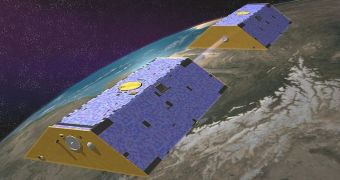Using data supplied by a NASA spacecraft, a team of experts at the University of Colorado in Boulder (UCB) was recently able to determine that global sea levels rose by 0.5 inches (12 millimeters) between 2003 and 2010. Though this may not seem like much, experts provide frightening statistics.
They say that the volume of water lost from Earth's glaciers – and especially ice fields in Antarctica and Greenland – is enough to cover the entire continental United States in more than 1.5 feet (0.5 meters) of water.
What the UCB group was especially interested in was figuring out how land ice masses shifted during the study period. In order to analyze that, they used data provided by the Gravity Recovery and Climate Experiment (GRACE), a joint mission between NASA and the German Aerospace Center (DLR).
This is the first investigation of its kind, and its conclusions are very worrying. Sea levels increased by a very wide margin, when factoring in the fact that it occurred over a period of only 7 years.
During the study period, Antarctica, Greenland and mountain glaciers lost a combined total of 1,000 cubic miles (4.3 trillion tons) of ice, which is a huge amount. As global warming accelerates, this rate is bound to increase soon, contributing to a large number of vicious circles.
“Earth is losing a huge amount of ice to the ocean annually, and these new results will help us answer important questions in terms of both sea rise and how the planet's cold regions are responding to global change,” UCB physics professor and study co-leader John Wahr explains.
“The strength of GRACE is it sees all the mass in the system, even though its resolution is not high enough to allow us to determine separate contributions from each individual glacier,” he goes on to say.
On average, Greenland and Antarctica – the two largest ice deposits on the planet – and their peripheral ice caps and glaciers, lost 385 billion tons (100 cubic miles) of ice annually. Other glaciers – some 200,000 of them – lost a combined total of roughly 148 billion tons (39 cubic miles) of ice.
Details of the investigation were published in the February 8 issue of the top scientific journal Nature.
“This study finds that the world's small glaciers and ice caps in places like Alaska, South America and the Himalayas contribute about .02 inches per year to sea level rise,” NASA Headquarters cryosphere program scientist Tom Wagner explains.
“While this is lower than previous estimates, it confirms that ice is being lost from around the globe, with just a few areas in precarious balance. The results sharpen our view of land ice melting, which poses the biggest, most threatening factor in future sea level rise,” he concludes.

 14 DAY TRIAL //
14 DAY TRIAL //